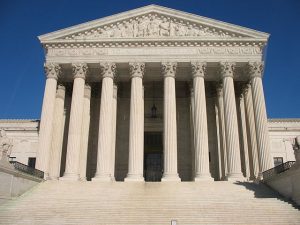By Erik Bootsma

After World War II, Bauhaus Modernism became the only acceptable form of architecture. It swept away the old “backwards” architecture. To create a new “rational” city of geometric precision, it created cities barren of individual ornament and beauty. This new architecture was needed to bring about architectural utopia, as when Le Corbusier had envisioned bulldozing most of Paris to erect miles of concrete apartment blocks. Thankfully, the French rejected such insanity, but the same could not be said of Americans.
In the 1960s and beyond, countless working-class neighborhoods were mowed down as part of an imagined “Urban Renewal” and replaced with new glass and steel office towers or acre upon acre of parking lots.
The working poor were shunted into shoddy housing projects built in “mass age” architecture, while the upper classes were safely whisked away to suburban tract homes on freeways bulldozed through the older parts of the city. The Johnson Administration’s “War on Poverty,” as Dr. Kirk notes, became through urban renewal “a war against the poor, for the advantage of the speculator and the contractor.”
Indeed, as Dr. Kirk notes, much of the destruction was “an unholy alliance” between business interests and corrupt politicians eager to use the power of eminent domain to enrich their allies. For example, in Detroit the city bulldozed the entire Poletown neighborhood to build a General Motors plant, over the violent protests of the people. And so it was for much of the post-war years in architecture.
By the 1980s, Modernism was in ascendance, and critics were few. Rare exceptions include Jane Jacobs, who had successfully lobbied against the government/corporate cabal of Robert Moses to save Greenwich Village, and the visionary Henry Hope Reed, who was unsuccessful in saving Pennsylvania Station from a similar fate. Given the rarity of critics of the Modernist and Post-Modernist architectural establishment at the time, Dr. Kirk seems a sort of architectural John the Baptist, a voice crying out against the concrete “air-conditioned urban jungle” and suburban tract houses of “third-rate materials and fourth-rate interior decoration.”
Dr. Kirk is more than a mere critic in “Servitude and Boredom” as he outlines an exemplary manifesto of principles that good architecture should express: “humane scale,” “the nurturing of roots,” the common good over mere commercial gain, and tradition. Ending on a somber but hopeful note, Kirk hopes that someday architects “endowed with the moral imagination” might “draw upon the architectural well of the past” and create a “strong and humane” architecture. It seemed fair to say his was a hope beyond hope at the time.
And yet a decade later there were already outposts in the wilderness, small groups who would embody Dr. Kirk’s principles of humane architecture. Dubbed by the New York Times the “young old fogies,” the Institute of Classical Architecture was founded in 1992 to embrace tradition and beauty in architecture. In 1996, the Congress for the New Urbanism, would urge “reconfiguration of sprawling suburbs into communities of real neighborhoods.” And in 1993, the University of Notre Dame re-founded its School of Architecture with a full commitment to teaching classical architecture and urbanism, a decision that would have been unthinkable a decade before. The tide had begun to turn.
In the forty years since Dr. Kirk’s cry in the wilderness, dozens of other organizations and institutions have sprung forth, each with a different “charism” yet each embracing some or all of the principles he had enumerated. From the National Civic Art Society, focused on beauty and symbolism in federal architecture, to Strong Towns, focused on neighborhood vitality and economy and safe streets, the movement toward humane architecture is growing.
Still, the architectural establishment in America remains dismissive and hostile to tradition and beauty in architecture, as illustrated by the furor over the White House’s rumored executive order giving preference to traditional and classical styles for federal building projects. Labeling classical architecture as “racist” and “backwards,” the desperation of the architectural press to maintain Modernism’s monopoly on federal dollars was transparent.
So there remains much to be done to rescue architecture and city planning from servitude and boredom. The academies, apart from Notre Dame and a few other small programs such as Benedictine College, remain in lockstep opposition to tradition, so little can be hoped for there. The unholy alliance of corporate interests and corrupt government, as the Kelo case illustrated, remain committed to using public power to seize private land for the benefit of the politically connected. Restrictive zoning laws prevent the creation of human-scale cities and communities and federal highway dollars pump the unremitting consumption of farmland to build ever more sprawling auto-oriented future slums.
Nevertheless, there has been a growing movement for the past generation toward humane cities and beautiful architecture, and a rejection of the banal architecture America has been subjected to for so many decades. If more architects were to read Dr. Kirk’s powerful essay and embrace the principles he articulates, we may hope that they will begin to work to create a truly beautiful and humane world.
Erik Bootsma is an architect working in Richmond, Virginia. He is a graduate of Thomas Aquinas College in California and the University of Notre Dame Architecture School.